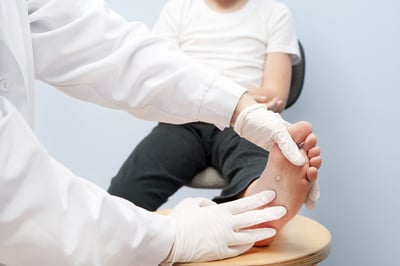FDA Approves New Treatment for Diabetic Foot Ulcers
By Emma Ryan
 Making major improvements over current standard of care – how does this new treatment work?
Making major improvements over current standard of care – how does this new treatment work?
The FDA recently approved a new indication for a product that has been used to heal burn wounds since 1996, now allowing for it to be used to treat diabetic foot ulcers. The product is called Integra Omnigraft Dermal Regeneration Matrix, or simply “Omnigraft.” This new indication is welcome news, as people with diabetes have a 25% lifetime risk of developing diabetic foot ulcers. Diabetic foot ulcers lead to a staggering 50,000 lower-limb amputations a year and cause more hospitalizations than any other diabetes complication.
The approval is based on results from the “FOUNDER study” of 307 people with foot ulcers, demonstrating significantly improved ulcer healing with the Omnigraft matrix compared to the current standard of care (which includes cleaning the wound, covering it with a surgical bandage, and keeping weight off that foot). How did the Omnigraft compare?
-
The Omnigraft led to wound closure five weeks quicker than with standard care: median time to wound closure was 43 days (about six weeks) with the Omnigraft vs. 78 days (about 11 weeks) with the standard care. This speed is critical, as chances of infection and other complications become much higher the longer a wound is left open.
-
51% of Omnigraft users had complete wound closure after 16 weeks, compared to only 32% with standard care.
-
16% of people using the Omnigraft experienced serious adverse events (such as infection or allergic reaction), compared to 27% of those with standard care
What is the Omnigraft and how does it work to treat diabetic foot ulcers?
The Omnigraft is used to help skin and blood vessels grow back healthily in areas where a wound – such as an ulcer – has occurred. It is made out of silicone, cow collagen, and shark cartilage. In a doctor’s office, a healthcare team first removes any dead or damaged tissue and cleans the affected area. Then, the Omnigraft is put over the ulcer in place of the removed tissue. Over time, skin cells grow back and new blood vessels are formed, eventually leading to permanent wound closure. In people with diabetic foot ulcers, the Omnigraft is approved for ulcers lasting over six weeks.
As standard diabetic ulcer care has failed to successfully treat so many people with this complication, new options such as this Omnigraft matrix have the potential to significantly improve patient outcomes. –AJW/ER







